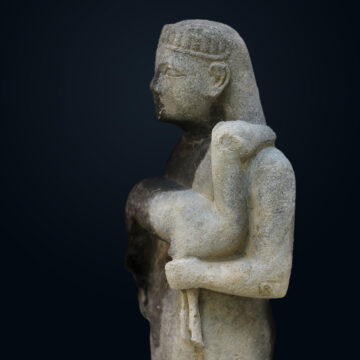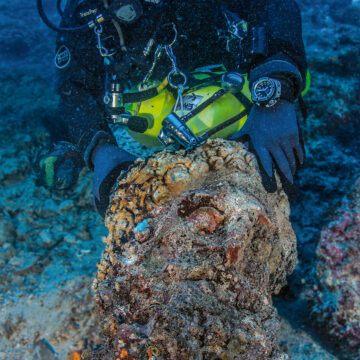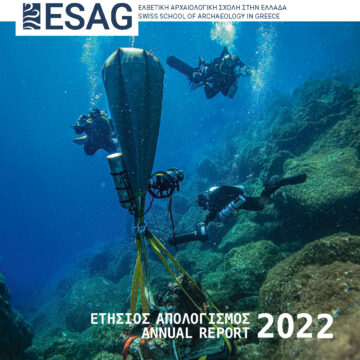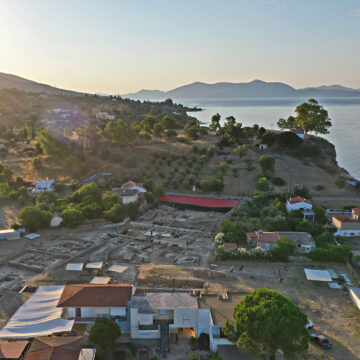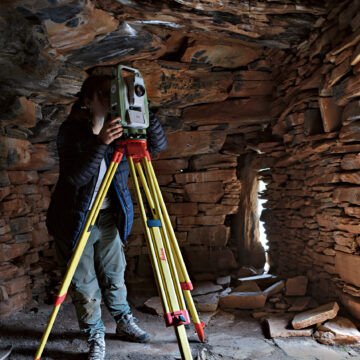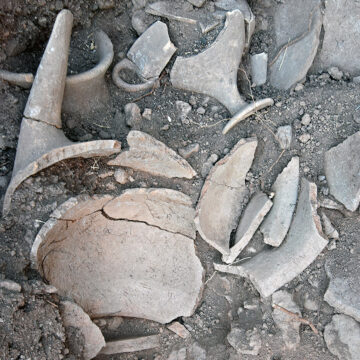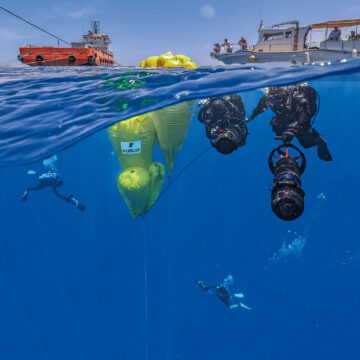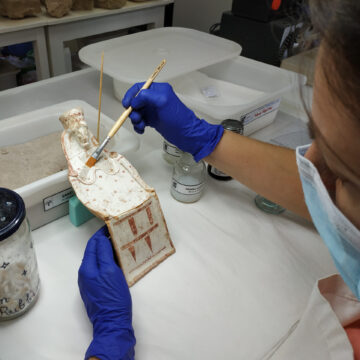Fieldwork 2022
While an archaeological project ever comes to a single artefact, the stone statuette discovered in the temple of Artemis Amarysia on 12 July 2022 embodies the Greco-Swiss excavations of the Artemision at Amarynthos. With her deep and calm glance, the female figure gently holds a fawn in her arms. This powerful image, which will undoubtedly find its place in ancient art books, was shared with the 93,000 readers and 7 million online visitors of the newspaper Le Temps, which chose it for its front page.
The other powerful image of 2022, printed by The New York Times on June 30 2022, takes us to the depths of the Aegean, off the island of Antikythera. A marble head of a bearded man has emerged to sunlight after 2.000 years, retaining the traits of Herakles despite the marine deposits covering its face.
Two statues from different periods, with different trajectories, histories, and contexts of discovery, yet both bear witness to the unique connectivity of the ancient Mediterranean. These exceptional discoveries, which highlight the scope of the projects carried out by the School in 2022, will also arouse public interest for years to come.
Two statues from different periods, with different trajectories, histories, and contexts of discovery, yet both bear witness to the unique connectivity of the ancient Mediterranean. These exceptional discoveries, which highlight the scope of the projects carried out by the School in 2022, will also arouse public interest for years to come.
The excavation at the Artemision of Amarynthos (Euboea)
In Amarynthos, the 2022 excavation campaign brought together a team of more than 70 people –a record for the ESAG– consisting of archaeologists, interns, workers, conservators, micromorphologists and geomorphologists. The excavation of the Late Archaic votive deposit found in 2020 was completed, increasing the number of artefacts to almost 700. This unique assemblage will lead to a better understanding of the cult practices and the identity of its dedicators. Since 2021, the excavation is reinforced by a systematic surface survey program. Almost 600 hectares have been explored between 2021 and 2022, which allowed the discovery of previously unknown ancient settlements. One of them, located 1 km from the Artemision, could have been the deme center of Amarynthos, known from inscriptions. The absence of a Classical settlement on the Paleoekklisies hill suggests that the area might have been dedicated to the deity. More broadly, the cross-examination of data from the excavations and the surface survey will allow to better apprehend the nature of the ancient sacred landscape, which is the focus of the current research project.
Sanctuary of Artemis in Amarynthos projectFieldwork on the “Dragon house” of Euboea
In 2022, the Greek-Swiss project of the “Drakospita” in the region of Styra focused on the excavation of the complex at Palli Lakka. Pottery finds allow to date the construction of this structure to the Late Hellenistic period. An important result of the campaign was the discovery of a monumental threshold in the southern edifice, which indicates the existence of a first level of occupation. The Roman pottery found in Palli Lakka, as well as the presence of numerous stone quarries in the vicinity, suggest that the use of these houses was related to stone quarrying. In addition, two other Drakospita, namely Makkou and Kapsala, were also documented. These were rather used as rural buildings.
The Dragon Houses of Euboea projectFieldwork on mount Oros, Aegina
The five-year research program on Hellanion Oros on the island of Aegina is composed by two main axis: the excavation on the summit, and the archaeological survey of the southern end of the island, around the mountain. During this second campaign, the work of the Greek-Swiss team focused on the documentation of the trenches opened in 2021 and on the study of the material, in particular the vases from a Mycenaean destruction layer. Nearly four millennia of human activity have been documented on the summit of this mountain, which served as a place of worship (sanctuary of Zeus) and as a habitat.
Underwater fieldwork at Antikythera
The 2022 excavation campaign at the Antikythera shipwreck has proven to be quite prosperous. By removing several boulders that had partially covered the excavation area, important discoveries were made and the recent excavations were linked to earlier finds. Thanks to the analyses carried out on site, more information about the wreck’s location is now available. The discovery of a marble head, presumably belonging to the statue of “Heracles of Antikythera”, which was discovered in 1901, is a promising sign for further research, which eventually aims at the accurate documentation and analysis of the wreck’s archaeological context.
Return to Antikythera project ESAG Antikythera projectThe offerings to Artemis under the microscope
The excavations in the sanctuary of Artemis at Amarynthos between 2020 and 2022 have yielded numerous archaeological finds. Therefore, at the end of the excavation in 2022, the conservation team was expanded, with the addition of four new conservators. Nevertheless, more than a decade will be needed to restore all the artifacts discovered so far. The variety of material categories of the finds requires great versatility and extensive technical expertise. Each object will require an individual and carefully considered treatment (see examples).
